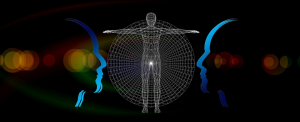TPN vs. DMN – Brain Structure and Mindfulness
July 15, 2017 ~ Written by: W.B. “Bud” Kirchner
 “Wisdom is the art of living happily, much of that art comes from seeing how we live unhappily.” – Larry Rosenberg
“Wisdom is the art of living happily, much of that art comes from seeing how we live unhappily.” – Larry Rosenberg
In addition to affecting how a brain ‘thinks’ mindfulness has also been shown to have actual physical effect on brain structure.
For some orientation I refer you back to Your Brain: By the Numbers.
The following reinforces the fact that reported improvements are not because people are just feeling better but because they are spending time relaxing.
A review of the literature shows some of the physical effects on the brain:
- Increased Grey Matter/Cortical Thickness in the following key areas: (How the Brain Changes When You Meditate by Jennifer Wolkin)
- Anterior Cingulate Cortex: as self-regulatory processes, including the ability to monitor attention conflicts, and allow for more cognitive flexibility.
- Prefrontal Cortex: executive functioning such as planning, problem solving, and emotion regulation.
- Hippocampus: governs learning and memory, and is extraordinarily susceptible to stress and stress-related disorders like depression or PTSD.
- In structures associated with self-awareness, compassion, and introspection
- Diminished or enhanced functionality in certain networks/connections
 Amongst the positive input on brain structure according to What Does Mindfulness Meditation Do to Your Brain? by Tom Ireland – and several other authors.
Amongst the positive input on brain structure according to What Does Mindfulness Meditation Do to Your Brain? by Tom Ireland – and several other authors.
- Brain’s “fight or flight” center, the amygdala, appears to diminish in size. This primal region of the brain, associated with fear and emotion, is implicated as the trigger of the body’s multifaceted response to stress.
- The connection between the amygdala and the rest of the brain gets weaker
- This disconnection of our mind from its “stress center” that seems to give rise to a range of physical as well as mental health benefits
- Connections between areas associated with attention and concentration get stronger
- Increased structural plasticity of distributed neural processes underlying attention and emotion
- Thickening of the cerebral cortex in areas associated with attention and emotional integration
- Enhanced connectivity between brain regions
- It appears the jury is still out as it relates to the impact on the insula but evidence is appearing
It would seem that changes correlate with hours meditated and are present even when not in meditating state – further lending credibility to the results.
Ireland also cited the work of Adrienne Taren a researcher studying mindfulness at the University of Pittsburg.
- Lots of activities can boost the size of various parts of the pre-frontal cortex – video games, for example – but it’s the disconnection of our mind from its “stress center” that seems to give rise to a range of physical as well as mental health benefits, says Taren.
- At this level of expertise, the pre-frontal cortex is no longer bigger than expected. In fact, its size and activity start to decrease again, says Taren. “It’s as if that way of thinking has become the default, it is automatic – it doesn’t require any concentration.”
In my opinion, these last two points are amazing! The latter is mind-blowing (sorry, I couldn’t resist).
As a summary note (dealing with an obvious question) Brewer et al (Meditation experience is associated with differences in default mode network activity and connectivity) found that the positive impacts on the brain were associated with three different types of meditation.
- Concentration
- Loving-Kindness
- Choiceless Awareness
Thus suggesting one has some flexibility in technique to get the afore mentioned benefits.
It is interesting that each of the major religions of this world utilizes some method to enable individuals to focus their attention, from meditation to prayer, to other contemplative practices.
“What lies behind us and what lies before us are tiny matters compared to what lies within us.” – Oliver Wendell Holmes
Further reading for those so inclined
- Mindfulness is associated with intrinsic functional connectivity between default mode and salience networks by Anselm Doll, Britta K. Hölzel, Christine C. Boucard, Afra M. Wohlschläger, and Christian Sorg
- Inside a Brain Circuit, the will to Press On by Emily Singer
- Mind-wandering and mindfulness by Susan L. Smalley Ph.D.
- “Neuroscience of Mindfulness: Default Mode Network, Meditation & Mindfulness” by Matthew Williams
- Meditation experience is associated with differences in default mode network activity and connectivity by Judson A. Brewer, Patrick D. Worhunsky, Jeremy R. Gray, Yi-Yuan Tang, Jochen Weber, and Hedy Kober
Still further reading for those who have inquisitive minds like me:
- The brain’s default mode network – what does it mean to us? by Svend Davanger
- Default-mode and task-positive network activity in Major Depressive Disorder: Implications for adaptive and maladaptive rumination by J. Paul Hamilton, Ph.D., Daniella J. Furman, M.A., Catie Chang, M.S., Moriah E. Thomason, Ph.D., Emily Dennis, B.A., and Ian H. Gotlib, Ph.D.
- Default mode network connectivity during task execution by D. Vatansevera, K. Menona, A.E. Manktelowa, B.J. Sahakianc, E.A. Stamatakisa,
- Default mode network segregation and social deficits in autism spectrum disorder: Evidence from non-medicated children by Benjamin E. Yerysa, Evan M. Gordone, Danielle N. Abramsb, Theodore D. Satterthwaiteg, Rachel Weinblattc, Kathryn F. Jankowskic, John Strangc, Lauren Kenworthyc, William D. Gaillardd, Chandan J. Vaidyad
- Development of the Default Mode and Central Executive Networks across early adolescence: A longitudinal study by Lauren E. Shermana, Jeffrey D. Rudieb, Jennifer H. Pfeiferc, Carrie L. Mastenb, Kristin McNealyb, Mirella Daprettob
- The fallacy of a “task-negative” network by R. Nathan Spreng
- Good at Task, Bad at People? By Sandeep Gautam
- The human brain is intrinsically organized into dynamic, anticorrelated functional networks by Michael D. Fox*†, Abraham Z. Snyder*‡, Justin L. Vincent*, Maurizio Corbetta‡, David C. Van Essen§,and Marcus E. Raichle
- Interactions Among the Brain Default-Mode, Salience, and Central-Executive Networks During Perceptual Decision-Making of Moving Dots by Chand GB, Dhamala M
- Interplay Between Default-Mode And Task-Positive Networks: Functional Characterization Of The Brain’s Large-Scale Neural Systems by Ching-nung Chen
- Know your brain: Default mode network (Neuroscientifically Challenged – blog)
- Salience network integrity predicts default mode network function after traumatic brain injury by Bonnelle V, Ham TE, Leech R, Kinnunen KM, Mehta MA, Greenwood RJ, Sharp DJ.
- 7 Ways Meditation Can Actually Change The Brain by Alice G. Walton
- Task-positive Functional Connectivity of the Default Mode Network Transcends Task Domain by Amanda Elton and Wei Gao
- What is the Default Mode Network? by Peter Pressman, MD
About the Author: W.B. “Bud” Kirchner is a serial entrepreneur and philanthropist with more than 50 years of business success. He is not a scientist or an academic but he does have a diversified exposure to neuroscience, psychology and related cognitive sciences. Generally speaking, the ideas he expresses here are business-angled expansions of other people’s ideas, so when possible, he will link to the original reference.
